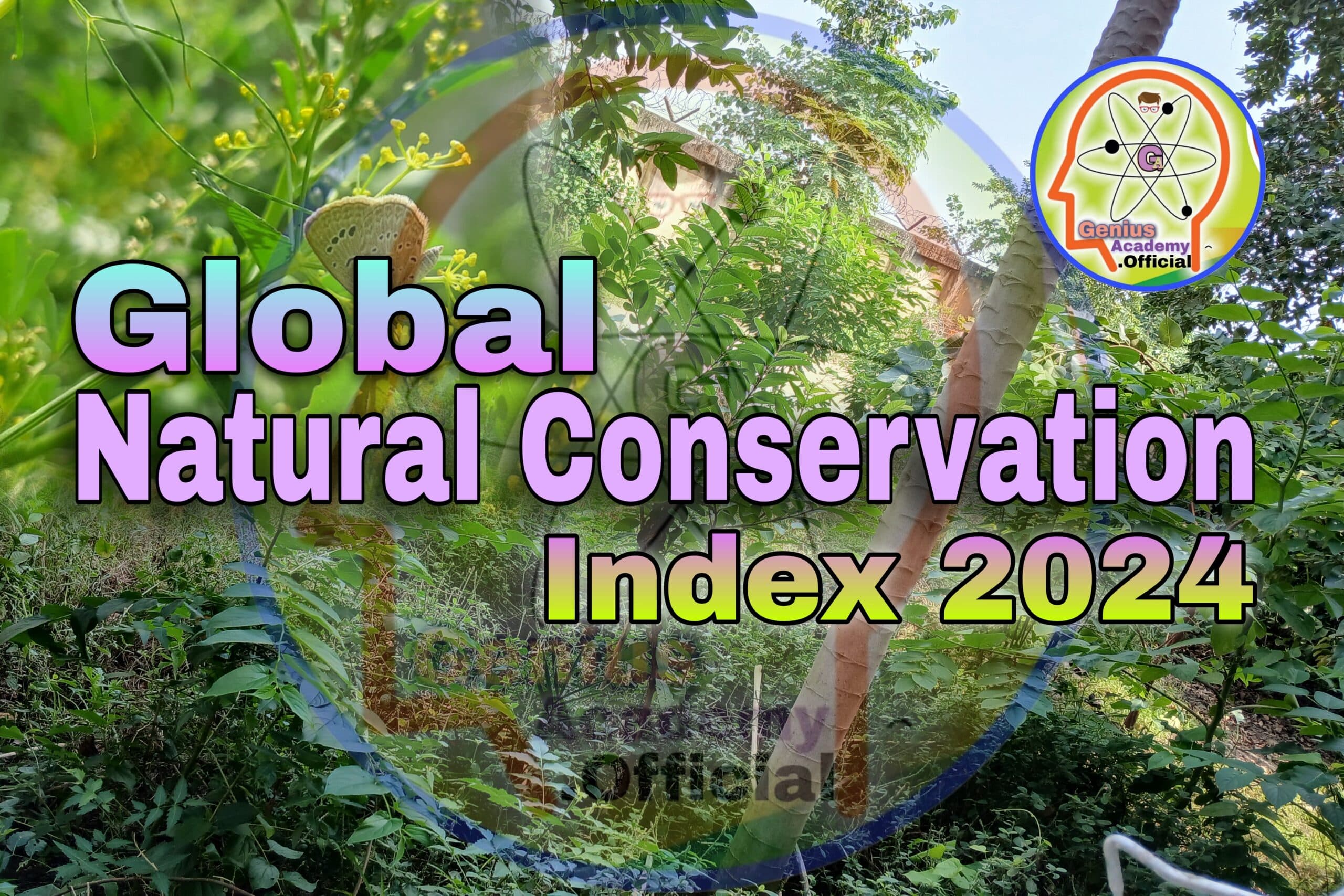
Global Nature Conservation Index (NCI), 2024
India has been ranked 176th out of 180 countries on the 2024 Global Nature Conservation Index (NCI), with a score of 45.5 (out of 100), placing it as one of the five worst performers alongside Kiribati (180), Turkey (179), Iraq (178) & Micronesia (177) in terms of environmental conservation. This index, first ever launched in October 2024, assesses countries based on land management, biodiversity threats, conservation capacity, and governance. India’s low ranking highlights significant challenges in managing its rich biodiversity and environmental resources, prompting a call for more effective policies and sustainable practices.
Top 10 Countries on the 2024 Global Nature Conservation Index
| Rank | Country | NCI 2024 Score |
|---|---|---|
| 1 | Luxembourg | 70.8 |
| 2 | Estonia | 70.5 |
| 3 | Denmark | 69.4 |
| 4 | Finland | 66.9 |
| 5 | United Kingdom | 66.6 |
| 6 | Zimbabwe | 65.9 |
| 7 | Australia | 65.8 |
| 8 | Switzerland | 64.7 |
| 9 | Romania | 64.6 |
| 10 | Costa Rica | 64.4 |
Key Findings on India’s Environmental Performance
- Declining Environmental Performance
Over the past decade, India’s Environmental Performance Index (EPI) has shown a significant decline, with rising levels of pollution and biodiversity threats. The NCI results reinforce this trend, underscoring the urgent need for enhanced conservation policies, sustainable resource management, and improved governance structures. - Reasons for India’s Low Ranking
India’s ranking on the NCI is primarily attributed to issues in biodiversity management, particularly the impacts of large-scale infrastructure projects, deforestation, and the limited efficacy of conservation laws. Additionally, weak legislation and inadequate regulation in natural resource management exacerbate these challenges. - Conservation Project Concerns
Projects like the Great Nicobar Island Development Project have drawn substantial criticism due to potential harm to biodiversity-rich ecosystems. Simultaneously, India has seen considerable deforestation, losing over 23,000 km² of tree cover between 2001 and 2019, impacting local flora, fauna, and indigenous communities.
About the Global Nature Conservation Index (NCI)
The Global Nature Conservation Index was developed by the Goldman Sonnenfeldt School of Sustainability and Climate Change at Ben-Gurion University of Negev, in collaboration with BioDB.com, a non-profit focused on biodiversity data. The index evaluates 180 countries across four primary pillars:
- Land Management – Focuses on the sustainable use and protection of land resources.
- Threats to Biodiversity – Measures the extent of risks to species and ecosystems.
- Capacity and Governance – Assesses the effectiveness of environmental regulations and institutions.
- Future Trends – Predicts potential outcomes based on current environmental policies and practices.
Using 25 performance indicators, the index aims to provide a comprehensive overview of global conservation efforts, enabling countries to evaluate and enhance their environmental policies.
Key Conservation Challenges in India
- Marine Conservation Shortfalls
Marine conservation emerged as another area where India requires significant improvement. Despite protecting 7.5% of its terrestrial territory, only 0.2% of national waterways fall under protected areas. Even more concerning, none of India’s Exclusive Economic Zone (EEZ) is currently under protection. Approximately 34.5% of fisheries in India’s Exclusive Economic Zone (EEZ) are overexploited. This overuse not only threatens marine biodiversity but also impacts coastal communities that depend on fishing for their livelihood. Strengthening marine conservation initiatives and expanding protected areas within India’s waterways and EEZ are necessary to address this gap. - Weak Legislation
India ranks 122nd in the effectiveness of laws and regulations related to natural resource management and biodiversity. The Forest Conservation (Amendment) Act, 2023 has been criticized for permitting commercial activities in forest areas without adequate environmental assessments, potentially accelerating deforestation and biodiversity loss. - Biodiversity at Risk
India’s low ranking in recent environmental assessments highlights critical issues in land management and biodiversity protection. According to the IUCN Red List, 15.9% of India’s marine species and 13.4% of terrestrial species are currently at risk. Expanding urbanization, pollution, and deforestation exacerbate these threats, making biodiversity conservation a critical area for policy reform. loss. - Inefficient Land Management
Inefficient land use, compounded by rapid urbanization and industrialization, has led to increased land conversion rates. Approximately 53% of land is now used for urban, industrial, and agricultural purposes, raising concerns over sustainable land use and environmental impact. - The Need for Sustainable Land Use
According to the IUCN Red List, 15.9% of India’s marine species and 13.4% of terrestrial species are currently at risk. Expanding urbanization, pollution, and deforestation exacerbate these threats, making biodiversity conservation a critical area for policy reform.
Recommendations for Improvement
- Increase Funding for Conservation
Enhancing government support for conservation programs, such as tiger reserves and community compensation, would encourage sustainable coexistence between humans and wildlife, benefiting both biodiversity and local communities. - Strengthen Environmental Legislation
Updating conservation laws and ensuring effective enforcement can significantly improve resource management. Increasing the effectiveness of environmental impact assessments for infrastructure projects is essential to prevent biodiversity degradation. - Renewable Energy and Sustainable Practices
Shifting toward renewable energy sources and improving energy efficiency can reduce environmental strain and aid in achieving global climate goals. Implementing carbon pricing and sustainable land-use practices will also contribute to conservation efforts. - Expanding Carbon Sinks
Protecting and expanding carbon sinks, such as forests and wetlands, can enhance carbon sequestration and mitigate the effects of climate change. Reforestation, especially in degraded areas, can bolster ecosystem health and resilience. efforts. - The Need for Sustainable Land Use
To address these challenges, adopting sustainable land use techniques has become essential. The assessment points out that India faces high levels of pesticide usage and warns against the growing issue of soil pollution. India’s sustainable nitrogen index currently stands at 0.77, suggesting that efforts to improve soil health through reduced pollutants and sustainable agricultural practices need urgent attention. efforts. - A Call for Comprehensive Environmental Management
India’s environmental challenges in both land and marine conservation underscore the need for a balanced approach to sustainability. Effective management of both terrestrial and marine ecosystems will be essential to safeguard biodiversity and promote long-term ecological health.
Conclusion
India’s low ranking on the Global Nature Conservation Index highlights the need for stronger conservation policies, enhanced regulation, and sustainable practices. Addressing issues such as biodiversity loss, deforestation, and inefficient resource management is critical for India to improve its environmental performance. By adopting a holistic approach and prioritizing ecological sustainability, India can make strides toward conserving its natural heritage for future generations.

